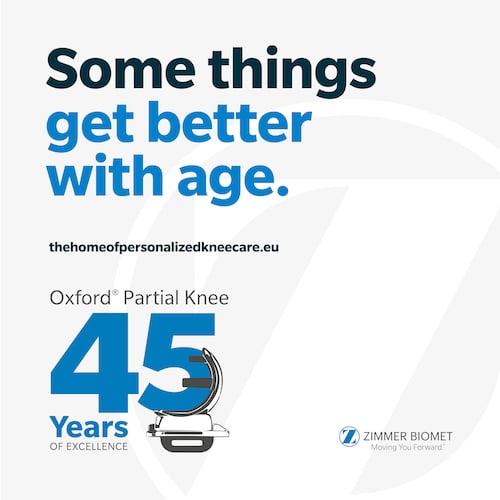Between December 2015 and May 2018, 143 patients with symptomatic isolated anteromedial osteoarthritis (AMOA) – who were suitable for both partial (PKA) and total knee arthroplasty (TKA) – were randomised 1:1 to receive either a medial PKA or a TKA.1 All procedures were conducted through a similar midline skin incision, and both the patients and assessors were blinded to the type of arthroplasty for the 2-year study period.
Outcome measures taken at 2, 12 and 24 months included the Oxford Knee Score (OKS), Knee Society Score (KSS), and the Knee injury and Osteoarthritis Outcome Score (KOOS). Radiographs were taken post-op day one, and then at 2, 12, and 24 months and reviewed for potential signs of failure such as component loosening or periprosthetic fractures. Complications and revisions were also assessed according to the Clavien-Dindo classification of complications.
The mean difference in the improvement of OKS between the study groups was 6.2 (p < 0.0001) at 2 months, and 3.2 points (p = 0.0067) at 12 months, both in favour of PKA. The differences observed at 2 months were both clinically and statistically significant. There were no significant differences between the groups for OKS at 24 months. Similarly, the KSS (p < 0.0001), and KOOS: pain (p < 0.0001), symptoms (p = 0.0002), function in daily life (p < 0.0001), sports and recreation (p < 0.0001), and quality of life (p = 0.0089) scores all demonstrated significant differences in favour of PKA at the 2-month follow-up.
At 12 months, the KOOS symptom (p = 0.0025), function and daily living (p = 0.0016) and pain scores (p = 0.0461) were all statistically significantly better for PKA than for TKA, but this difference was not clinically significant. At 24 months, the difference for the KOOS symptom score remained statistically significant (p = 0.0491), but no longer reached clinical significance.
There were no differences between the study groups for revisions, infections, post-op haematoma, post-op fracture or complications according to the Clavien-Dindo classification at 12 or 24 months. However, at 24 months, more patients in the TKA group demonstrated a restricted range of movement requiring a manipulation under anaesthesia than in the PKA group (5 Vs 0 patients, p = 0.0280).
The authors concluded that while functional results were comparable at 24 months, medial PKA provided faster post-op recovery than TKA, and therefore supported the use of medial PKA in patients with AMOA.

